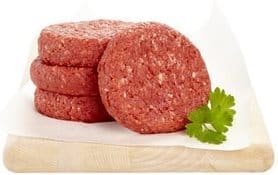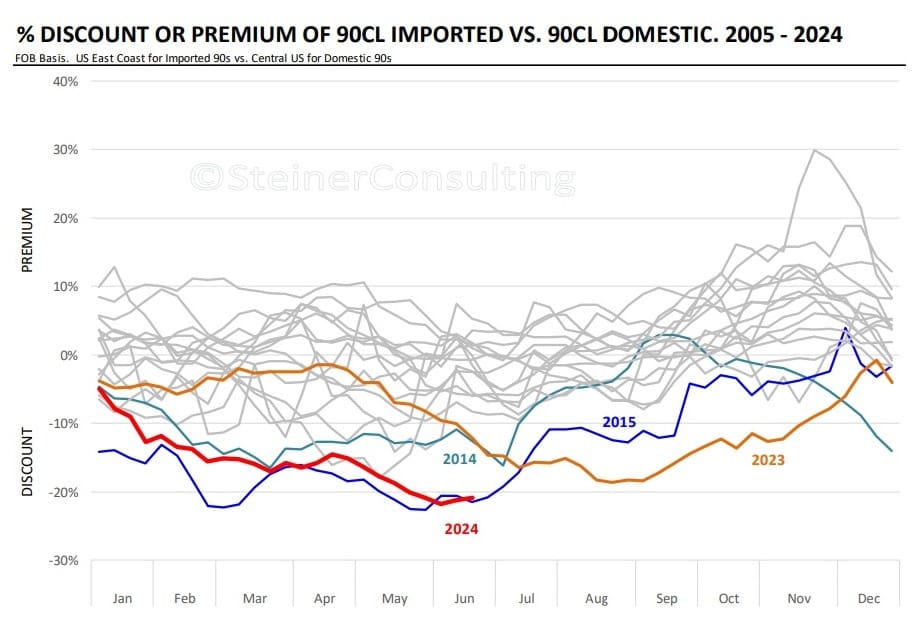There’s been a moderate improvement in imported manufacturing beef prices into the US over the past fortnight, however a near-record large discount still applies between imported and domestic US product.
 Lean 90CL imported cow beef was quoted at A912c/kg last week, a 28c/kg rise on the week before, following the upward trend in US lean beef values, overall US wholesale beef prices and new record US cattle prices as US cattle availability slows.
Lean 90CL imported cow beef was quoted at A912c/kg last week, a 28c/kg rise on the week before, following the upward trend in US lean beef values, overall US wholesale beef prices and new record US cattle prices as US cattle availability slows.
Uncertainty about demand back in April and May and caused US end-users and buyers to sit on the sidelines, and many had already adequately covered their second quarter needs, Steiner Consulting says in its latest weekly imported beef report.
“Eventually, however, positions get shorter and the recent rally was a reminder of the need to stay ahead of the market,” Steiner said.
The fact that US fed cattle values and USDA Choice beef cutout have been resilient post Memorial Day (27 May) was also a surprise.
“The middle of the northern hemisphere summer may be around the corner, but for US buyers, the primary goal at the moment is to maintain coverage, especially in light of record domestic lean beef prices,” last week’s report said.
“Those that can use imported beef in their formulations (some US end-users maintain a domestic source only policy) are already maximising inclusion.”
Discounts for imported trimmings versus US domestic had in some cases surpassed US80c/lb, which would be a record high in dollar terms, Steiner said (see graph).

However, the discount so far this year (red line) had been almost exactly the same as it was in 2015 (blue line), the last time the US beef industry was in a similar post drought recovery situation.
The question going forward would be whether the discount on imported beef would be sustained in the second half of the year, Steiner said.
“History tells us it will not. During the last cyclical lows, the biggest spread happened in May and June period, when domestic supply declines, imported supply increases and US retail and food service demand driving this tends to be at its peak.”
As the US moves into September, grilling demand slows down, domestic culling rate seasonally improves (it still remains below year ago) and there is less imported beef in the market, primarily from New Zealand.
“For buyers, the incentive is to continue to secure needs now, given the wide spread between imported and domestic beef,” Steiner said.
Imported round cuts prices have continue to trade very firm, a function of firm prices for domestic round cuts. Last year, US domestic round and chuck beef prices took off in August as retailers started to lay the groundwork for northern hemisphere autumn specials.
That memory and record domestic cattle prices have buyers of imported rounds raising their bids to get needs covered, Steiner said.
Brazilian imports
Steiner noted that Brazilian beef shipments for June to date have reached more than 10,000 tonnes – more than what was shipped in March and April combined.
“The thinking was that if US imported beef prices continued to trend higher, it would help offset the impact of the 26.4pc tariff imposred on Brazil,” Steiner said.
Operating under the US’s modestly-sized ‘Other Country’ imported beef quota, Brazil filled its 2024 quota back in March, and must pay the 26.4pc tariff for the remainder of the year – to Australia’s advantage.
“However, it is also important to remember that Brazilian cattle prices have been trading well below year ago levels for much of this year,” Steiner said. “The strong US dollar only adds to the incentive to ship to the US, despite the high tariff.”
In the last month, alone, the US$ has gained 6pc versus the Brazilian Real.
Some in Australia have formed the opinion that low prices for the larger quantities of Brazilian imported manufacturing beef now being seen in the US market are in turn limiting prtices for Australian imported.
US pasture conditions
In the last two weeks, US pasture conditions have started to slip and that trend may continue now that high temperatures and lack of moisture impacts large portions of the country, Steiner’s weekly report said.
For the week ending 16 June, USDA noted that 48pc of pastures and ranges were in good/excellent condition, three points lower than at the start of the month, with the pasture rating still about four points higher than a year ago and far better than the 31pc rating in 2022.
“The improvement has allowed US producers to return to a more ‘normal’ culling rate this spring,” Steiner said.
“Expectations are for cow slaughter to remain well below year ago levels through the summer, in part because there are simply fewer cows out there. However, feed availability will dictate the magnitude of the shortfall.”
New Zealand slaughter declines
New Zealand’s highly seasonal cow slaughter is now 14pc below this time last year, and is currently estimated to be around 20,000-22,000 head per week.
“Cow slaughter in New Zealand will then drift even lower in July and August and by September should be under 10,000 head/week,” Steiner said. “The decline will limit the amount of beef New Zealand suppliers are willing/able to show for delivery Aug-Oct, one of the reasons contributing to the tightening spread between domestic and imported beef in the second half.”

I’m a little confused, your article says 90CL is 912 this week after a 28 cent rise but in your Meat Indicator at the bottom of Beef Central is says 90CL is 884 down 23 cents?
Thanks for your comment Greg. Our graph plug-in takes a while to respond after we add a new weekly data point. It’s showing correctly now, with the latest entry included. Additionally, there is a lag of up to a week between MLA’s reported 90CL imported beef price in the US, and actual trading figures in the market today. Editor